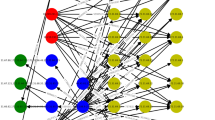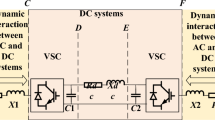Abstract
Analyzing the vulnerability of power systems in cascading failures is generally regarded as a challenging problem. Although existing studies can extract some critical rules, they fail to capture the complex subtleties under different operational conditions. In recent years, several deep learning methods have been applied to address this issue. However, most of the existing deep learning methods consider only the grid topology of a power system in terms of topological connections, but do not encompass a power system’s spatial information such as the electrical distance to increase the accuracy in the process of graph convolution. In this paper, we construct a novel power-weighted line graph that uses power system topology and spatial information to optimize the edge weight assignment of the line graph. Then we propose a multi-graph convolutional network (MGCN) based on a graph classification task, which preserves a power system’s spatial correlations and captures the relationships among physical components. Our model can better handle the problem with power systems that have parallel lines, where our method can maintain desirable accuracy in modeling systems with these extra topology features. To increase the interpretability of the model, we present the MGCN using layer-wise relevance propagation and quantify the contributing factors of model classification.
摘要
分析电力系统在连锁故障中的薄弱环节是电力系统分析领域极具挑战的难题。电力系统领域的传统分析方法虽能发现一些简单的传播规律,但却难以捕捉不同运行条件下的复杂细节。近年来的研究引入了深度学习算法来解决这一难题。然而,现有基于深度学习的方法大多仅从拓扑层面考虑电力系统的网架结构,未能充分考虑空间信息(如电距离)以提高图卷积过程的精确度。鉴于此,本文提出一种新型电力系统加权线图,综合考虑电力系统拓扑结构和空间信息,大幅优化线图的边权分配。此外,本文提出一种基于图分类任务的多图卷积网络(MGCN),在保留电力系统空间相关性的同时有效捕获物理元件之间的关联。经验证,该模型能够在具有额外拓扑特征的建模系统中保持理想精度,从而更好地分析存在并行输电线路的复杂连锁故障。最后,本文采用逐层相关传播方法解释MGCN,并量化了模型分类的贡献因子,有效提升模型的可解释性。
Similar content being viewed by others
References
Bach S, Binder A, Montavon G, et al., 2015. On pixel-wise explanations for non-linear classifier decisions by layer-wise relevance propagation. PLoS ONE, 10(7):e0130140. https://doi.org/10.1371/journal.pone.0130140
Bandyopadhyay S, Biswas A, Murty MN, et al., 2019. Beyond node embedding: a direct unsupervised edge representation framework for homogeneous networks. https://doi.org/10.48550/arXiv.1912.05140
Bolz V, Rueß J, Zell A, 2019. Power flow approximation based on graph convolutional networks. Proc 18th IEEE Int Conf on Machine Learning and Applications, p.1679–1686. https://doi.org/10.1109/ICMLA.2019.00274
Bruna J, Zaremba W, Szlam A, et al., 2014. Spectral networks and locally connected networks on graphs. Proc 2nd Int Conf on Learning Representations, p.1–14.
Bucolo M, Buscarino A, Famoso C, et al., 2021. Chaos addresses energy in networks of electrical oscillators. IEEE Access, 9:153258–153265. https://doi.org/10.1109/ACCESS.2021.3127319
Chen G, Dong ZY, Hill DJ, et al., 2010. Attack structural vulnerability of power grids: a hybrid approach based on complex networks. Phys A Stat Mech Appl, 389(3): 595–603. https://doi.org/10.1016/j.physa.2009.09.039
Chen KJ, Hu J, Zhang Y, et al., 2020. Fault location in power distribution systems via deep graph convolutional networks. IEEE J Sel Area Commun, 38(1):119–131. https://doi.org/10.1109/JSAC.2019.2951964
Defferrard M, Bresson X, Vandergheynst P, 2016. Convolutional neural networks on graphs with fast localized spectral filtering. Proc 30th Int Conf on Neural Information Processing Systems, p.3844–3852.
di Muro MA, Valdez LD, Rêgo HHA, et al., 2017. Cascading failures in interdependent networks with multiple supply-demand links and functionality thresholds. Sci Rep, 7(1):15059. https://doi.org/10.1038/s41598-017-14384-y
Eppstein MJ, Hines PDH, 2012. A “random chemistry” algorithm for identifying collections of multiple contingencies that initiate cascading failure. IEEE Trans Power Syst, 27(3):1698–1705. https://doi.org/10.1109/TPWRS.2012.2183624
Fang JY, Wu JJ, Zheng ZB, et al., 2021. Revealing structural and functional vulnerability of power grids to cascading failures. IEEE J Emerg Sel Top Circ Syst, 11(1):133–143. https://doi.org/10.1109/JETCAS.2020.3033066
Gambuzza LV, Buscarino A, Fortuna L, et al., 2017. Analysis of dynamical robustness to noise in power grids. IEEE J Emerg Sel Top Circ Syst, 7(3):413–421. https://doi.org/10.1109/JETCAS.2017.2649598
Gao HY, Ji SW, 2019. Graph U-Nets. Proc 36th Int Conf on Machine Learning, p.2083–2092.
Ge LJ, Liao WL, Wang SX, et al., 2020. Modeling daily load profiles of distribution network for scenario generation using flow-based generative network. IEEE Access, 8:77587–77597. https://doi.org/10.1109/ACCESS.2020.2989350
Henaff M, Bruna J, LeCun Y, 2015. Deep convolutional networks on graph-structured data. https://arxiv.org/abs/1506.05163
Hu JL, Li TH, Dong SB, 2020. GCN-LRP explanation: exploring latent attention of graph convolutional networks. Proc Int Joint Conf on Neural Networks, p.1–8. https://doi.org/10.1109/IJCNN48605.2020.9207639
Kim C, Kim K, Balaprakash P, et al., 2019. Graph convolutional neural networks for optimal load shedding under line contingency. Proc IEEE Power & Energy Society General Meeting, p.1–5. https://doi.org/10.1109/PESGM40551.2019.8973468
Kipf TN, Welling M, 2017. Semi-supervised classification with graph convolutional networks. Proc 5th Int Conf on Learning Representations, p.1–14.
Knyazev B, Lin X, Amer MR, et al., 2018. Spectral multigraph networks for discovering and fusing relationships in molecules. https://arxiv.org/abs/1811.09595
Kohlbrenner M, Bauer A, Nakajima S, et al., 2020. Towards best practice in explaining neural network decisions with LRP. Proc Int Joint Conf on Neural Networks, p.1–7. https://doi.org/10.1109/IJCNN48605.2020.9206975
León-Montiel RD, Quiroz-Juárez MA, Quintero-Torres R, et al., 2015. Noise-assisted energy transport in electrical oscillator networks with off-diagonal dynamical disorder. Sci Rep, 5:17339. https://doi.org/10.1038/srep17339
Li Q, Liao YX, Wu KM, et al., 2021. Parallel and distributed optimization method with constraint decomposition for energy management of microgrids. IEEE Trans Smart Grid, 12(6):4627–4640. https://doi.org/10.1109/TSG.2021.3097047
Li X, Qi ZT, 2021. Impact of cascading failure based on line vulnerability index on power grids. Energy Syst, early access. https://doi.org/10.1007/s12667-021-00435-x
Liao WL, Yang DC, Wang YS, et al., 2021. Fault diagnosis of power transformers using graph convolutional network. CSEE J Power Energy Syst, 7(2):241–249. https://doi.org/10.17775/CSEEJPES.2020.04120
Liu YX, Zhang N, Wu D, et al., 2021. Searching for critical power system cascading failures with graph convolutional network. IEEE Trans Contr Netw Syst, 8(3): 1304–1313. https://doi.org/10.1109/TCNS.2021.3063333
Lonapalawong S, Yan JZ, Li JY, et al., 2022. Reducing power grid cascading failure propagation by minimizing algebraic connectivity in edge addition. Front Inform Technol Electron Eng, 23(3):382–397. https://doi.org/10.1631/FITEE.2000596
Luo B, Wang HT, Liu HQ, et al., 2019. Early fault detection of machine tools based on deep learning and dynamic identification. IEEE Trans Ind Electron, 66(1):509–518. https://doi.org/10.1109/TIE.2018.2807414
Mei SW, He F, Zhang XM, et al., 2009. An improved OPA model and blackout risk assessment. IEEE Trans Power Syst, 24(2):814–823. https://doi.org/10.1109/TPWRS.2009.2016521
Montavon G, Binder A, Lapuschkin S, et al., 2019. Layer-wise relevance propagation: an overview. In: Samek W, Montavon G, Vedaldi A, et al. (Eds.), Explainable AI: Interpreting, Explaining and Visualizing Deep Learning. Springer, Cham, p.193–209. https://doi.org/10.1007/978-3-030-28954-6_10
Owerko D, Gama F, Ribeiro A, 2018. Predicting power outages using graph neural networks. Proc IEEE Global Conf on Signal and Information Processing, p.743–747. https://doi.org/10.1109/GlobalSIP.2018.8646486
Pizzuti C, Socievole A, van Mieghem P, 2020. Comparative network robustness evaluation of link attacks. Proc Int Conf on Complex Networks and Their Applications, p.735–746. https://doi.org/10.1007/978-3-030-36687-2_61
Ren WD, Wu JJ, Zhang X, et al., 2018. A stochastic model of cascading failure dynamics in communication networks. IEEE Trans Circ Syst II Expr Briefs, 65(5):632–636. https://doi.org/10.1109/TCSII.2018.2822049
Schnake T, Eberle O, Lederer J, et al., 2020. Higher-order explanations of graph neural networks via relevant walks. https://arxiv.org/abs/2006.03589v3
Schneider CM, Moreira AA, Andrade JS Jr, et al., 2011. Mitigation of malicious attacks on networks. Proc Natl Acad Sci USA, 108(10):3838–3841. https://doi.org/10.1073/pnas.1009440108
Song JJ, Cotilla-Sanchez E, Ghanavati G, et al., 2016. Dynamic modeling of cascading failure in power systems. IEEE Trans Power Syst, 31(3):2085–2095. https://doi.org/10.1109/TPWRS.2015.2439237
Springenberg JT, Dosovitskiy A, Brox T, et al., 2015. Striving for simplicity: the all convolutional net. Proc 3rd Int Conf on Learning Representations, p.1–14.
Tong HJ, Qiu RC, Zhang DX, et al., 2021. Detection and classification of transmission line transient faults based on graph convolutional neural network. CSEE J Power Energy Syst, 7(3):456–471. https://doi.org/10.17775/CSEEJPES.2020.04970
Wu J, Barahona M, Tan YJ, et al., 2011. Spectral measure of structural robustness in complex networks. IEEE Trans Syst Man Cybern Part A Syst Humans, 41(6):1244–1252. https://doi.org/10.1109/TSMCA.2011.2116117
Ying R, He RN, Chen KF, et al., 2018. Graph convolutional neural networks for web-scale recommender systems. Proc 24th ACM SIGKDD Int Conf on Knowledge Discovery & Data Mining, p.974–983. https://doi.org/10.1145/3219819.3219890
Zeiler MD, Fergus R, 2014. Visualizing and understanding convolutional networks. Proc 13th European Conf on Computer Vision, p.818–833.
Zhang X, Tse CK, 2015. Assessment of robustness of power systems from a network perspective. IEEE J Emerg Sel Top Circ Syst, 5(3):456–464. https://doi.org/10.1109/JETCAS.2015.2462152
Zhang X, Zhan CJ, Tse CK, 2017. Modeling the dynamics of cascading failures in power systems. IEEE J Emerg Sel Top Circ Syst, 7(2):192–204. https://doi.org/10.1109/JETCAS.2017.2671354
Zhou BL, Khosla A, Lapedriza À, et al., 2016. Learning deep features for discriminative localization. Proc IEEE Conf on Computer Vision and Pattern Recognition, p.2921–2929. https://doi.org/10.1109/CVPR.2016.319
Zhu YH, Yan J, Sun Y, et al., 2014. Revealing cascading failure vulnerability in power grids using risk-graph. IEEE Trans Parall Distrib Syst, 25(12):3274–3284. https://doi.org/10.1109/TPDS.2013.2295814
Zimmerman RD, Murillo-Sánchez CE, Thomas RJ, 2011. MATPOWER: steady-state operations, planning, and analysis tools for power systems research and education. IEEE Trans Power Syst, 26(1):12–19. https://doi.org/10.1109/TPWRS.2010.2051168
Author information
Authors and Affiliations
Corresponding author
Additional information
Project supported by the National Natural Science Foundation of China (No. U1866602) and the Natural Science Foundation of Zhejiang Province, China (No. LZ22F020015)
Contributors
Supaporn LONAPALAWONG designed the study and addressed the problems. Changsheng CHEN processed the data. Supaporn LONAPALAWONG drafted the paper. Changsheng CHEN helped with the technical information. Wei CHEN contributed to material and computing resources, and supervised the study. Can WANG helped organize the paper. Supaporn LONAPALAWONG and Changsheng CHEN revised and finalized the paper.
Compliance with ethics guidelines
Supaporn LONAPALAWONG, Changsheng CHEN, Can WANG, and Wei CHEN declare that they have no conflict of interest.
Rights and permissions
About this article
Cite this article
Lonapalawong, S., Chen, C., Wang, C. et al. Interpreting the vulnerability of power systems in cascading failures using multi-graph convolutional networks. Front Inform Technol Electron Eng 23, 1848–1861 (2022). https://doi.org/10.1631/FITEE.2200035
Received:
Accepted:
Published:
Issue Date:
DOI: https://doi.org/10.1631/FITEE.2200035




